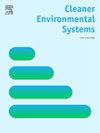Dynamic vs real time life cycle assessment
IF 4.9
Q2 ENGINEERING, ENVIRONMENTAL
引用次数: 0
Abstract
The term “conventional” or “static” Life Cycle Assessment (LCA) is used to describe the traditional application of LCA for the environmental impact assessment of a given instance of a system, to differentiate it from the recently developed Dynamic Life Cycle Assessment (DLCA). The latter is defined as monitoring and assessing the environmental performance of a continuously changing system. However, the term “dynamic” has been interpreted differently in various studies, with the temporal aspect of the analysis being satisfied either with the use of timeseries of (historical/predicted) data or with a real-time data collection for the system in question. The focus of this review paper is: (a) to examine the implementation of DLCA by findings common themes, differences and challenges in its application to different sectors, and (b) identify and highlight the differences between dynamic assessment and real-time assessment.
The review has shown that in the last five years the published literature has grown, with the annual number of articles increasing from less than 30 (between 2015 and 2019) to 62 in 2023. In terms of the traditional LCA steps, the Dynamic Process Inventory is usually populated eiterh (a) with historical data for certain elementary flows and/or (b) using alternative scenarios for selected elementary flows. Dynamic Characterisation is only needed when the time horizon is longer than a decade, while Dynamic Systems had been mostly implemented in correlation with the Building Information Model (BIM). The sectors where DLCA has been predominantly used are: (a) buildings; (b) waste treatment and management; (c) agriculture; and (d) utilities (i.e. energy production and water supply).
On the contrary, the term “real-time LCA” is rarely used, with only a handful of published papers referring to it, but none of these implemented in a real-life industrial system. Although several studies agree that real-time assessment leads to improved accuracy, better insight to the process and time savings in the analysis, the effort required to implement it and the added value to the industrial plant, does not currently justify its wider implementation. However, in the era of Industry 4.0 and the digitization of industrial plants, there is an opportunity to incorporate the environmental impact assessment in the continuous monitoring of process industries.
动态vs实时生命周期评估
“常规”或“静态”生命周期评估(LCA)一词用于描述LCA的传统应用,用于对系统的给定实例进行环境影响评估,以区别于最近发展的动态生命周期评估(DLCA)。后者被定义为监测和评估一个不断变化的系统的环境绩效。然而,“动态”一词在各种研究中有不同的解释,分析的时间方面要么满足于使用(历史/预测)数据的时间序列,要么满足于所讨论系统的实时数据收集。本检讨文件的重点是:(a)透过发现在不同界别应用DLCA的共同主题、差异和挑战,来检视DLCA的推行情况,以及(b)厘清和强调动态评估与实时评估之间的差异。该综述显示,在过去五年中,已发表的文献数量有所增长,每年的文章数量从2015年至2019年的不到30篇增加到2023年的62篇。就传统的LCA步骤而言,动态过程清单通常是(a)使用某些基本流的历史数据和/或(b)使用所选基本流的替代方案填充的。只有当时间跨度超过十年时才需要动态特性,而动态系统主要是与建筑信息模型(BIM)相关实施的。主要使用DLCA的界别有:(a)楼宇;(b)废物处理和管理;(c)农业;(d)公用事业(即能源生产和供水)。相反,“实时LCA”这个术语很少使用,只有少数发表的论文提到了它,但这些都没有在现实生活中的工业系统中实现。虽然几项研究都认为实时评估可以提高准确性,更好地了解过程,节省分析时间,但实施它所需的努力和工业工厂的附加值,目前还不能证明它的广泛实施是合理的。然而,在工业4.0和工业工厂数字化时代,有机会将环境影响评估纳入过程工业的持续监测中。
本文章由计算机程序翻译,如有差异,请以英文原文为准。
求助全文
约1分钟内获得全文
求助全文
来源期刊

Cleaner Environmental Systems
Environmental Science-Environmental Science (miscellaneous)
CiteScore
7.80
自引率
0.00%
发文量
32
审稿时长
52 days
 求助内容:
求助内容: 应助结果提醒方式:
应助结果提醒方式:


